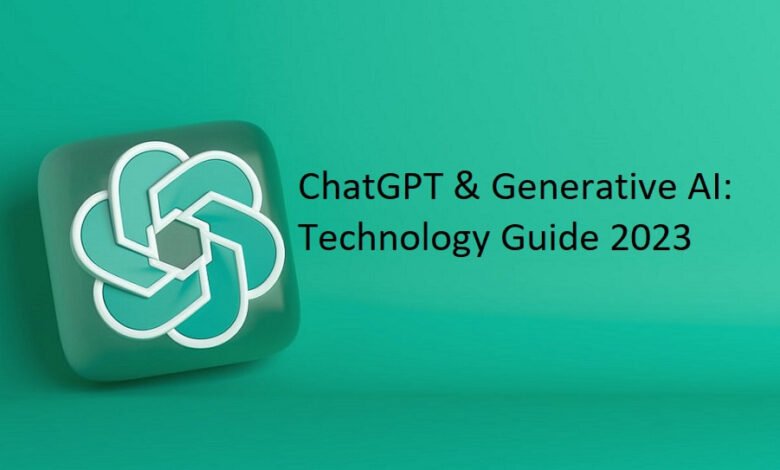
In recent years, there has been a remarkable advancement in artificial intelligence (AI), particularly in generative models. These models, such as ChatGPT, have gained the significant capacity to produce writing that resembles human language and engage in conversational interactions. In this technology guide for 2023, we will explore ChatGPT and generative AI, their applications, benefits, limitations, and the future they hold.
Understanding ChatGPT and Generative AI
ChatGPT is a prime example of a Generative AI model based on the GPT (Generative Pre-trained Transformer) architecture. It is designed to generate text that mimics human-like responses conversationally. Trained on vast amounts of data, ChatGPT can understand context, generate coherent responses, and engage in interactive conversations with users.
Generative AI is a class of AI models that generate new content, such as text, images, and music, based on the patterns and knowledge learned from training data. These models leverage deep learning techniques, particularly transformer architectures, to process and generate complex data sequences.
Applications of ChatGPT and Generative AI
ChatGPT and generative AI applications are vast and span various industries. Here are some notable use cases:
Virtual Assistants and Customer Support
ChatGPT can be deployed as virtual assistants or chatbots to provide personalized customer support and answer frequently asked questions. Understanding the situation and producing human-like responses enhances the user experience and alleviates the burden on human support agents.
Content Generation
Generative AI models like ChatGPT can assist content creators by generating ideas, brainstorming topics, and even providing draft content. They can be used to automate content creation for blogs, social media posts, and marketing materials, saving time and effort.
Language Translation and Summarization
Generative AI models have shown promise in language translation and summarization tasks. They can generate translations or summaries that capture the essence of the original text, facilitating cross-language communication and information extraction.
Creative Writing and Storytelling
Writers and storytellers can utilize ChatGPT to generate creative content. From developing character dialogues to exploring new narrative directions, generative AI models can be collaborative tools for creative professionals.
Education and Training
The potential for generative AI models to revolutionize education and training by providing interactive and personalized learning experiences. They can simulate conversations, answer questions, and assist learners in acquiring knowledge more engagingly and interactively.
Benefits and Limitations
While ChatGPT and generative AI offer exciting possibilities, it’s essential to consider their benefits and limitations.
Benefits
- Efficiency: Generative AI models can automate tasks, saving time and effort in various domains.
- Scale: These models can handle large volumes of data and generate content at scale.
- Personalization: Generative AI enables personalized experiences by tailoring responses to individual users’ needs and preferences.
- 24/7 Availability: Virtual assistants and chatbots powered by generative AI can provide round-the-clock support and engagement.
Limitations
- Contextual Understanding: Generative AI models might need help understanding nuanced context, leading to occasional inaccuracies or misinterpretations.
- Ethical Considerations: There are concerns regarding the ethical use of generative AI, such as misinformation or biased responses that can emerge from limited training data.
- Lack of Common Sense: Generative AI models may generate plausible-sounding but factually
The Future of ChatGPT and Generative AI
The future of ChatGPT and generative AI is filled with possibilities and ongoing research to address their limitations. Here are some critical areas of development:
- Model Improvements: Researchers continuously work to enhance generative AI models like ChatGPT by incorporating advanced techniques such as reinforcement learning and better training strategies. These improvements improve the models’ understanding of context and generate more accurate and contextually appropriate responses.
- Ethical Considerations: Addressing ethical concerns related to generative AI is crucial. Efforts are being made to develop frameworks that promote responsible AI usage, including fairness, transparency, and accountability. Stricter guidelines and regulations can help ensure the ethical deployment of generative AI models.
- Multimodal Capabilities: Future developments may involve combining generative AI with other modalities like images and videos, enabling more interactive and immersive experiences. This integration could lead to advanced chatbots that generate text and provide visual or auditory responses.
- Continual Learning: Researchers are exploring ways to enable generative AI models to learn continually from user interactions, improving their performance over time. This approach allows the models to adapt to new scenarios, acquire domain-specific knowledge, and enhance the quality of generated responses.
Conclusion
ChatGPT and generative AI represent a significant milestone in developing AI technology. With their ability to generate human-like text and engage in conversations, these models offer immense potential across various industries. From virtual assistants to content generation and education, the applications of generative AI are diverse and ever-expanding. However, it is essential to recognize the limitations and ethical considerations associated with generative AI. Ongoing research and responsible deployment are necessary to address these concerns and ensure the technology is used ethically and for the benefit of society.




